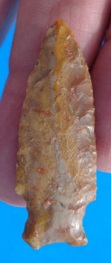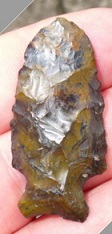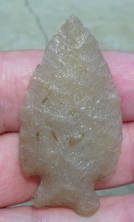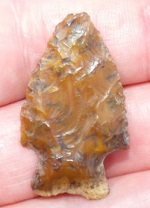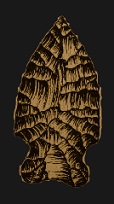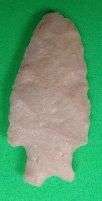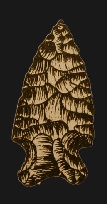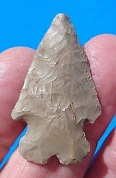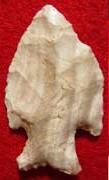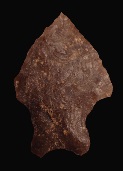Outline is Representative of Size and Shape:

Name Details:
Identified By: Richard P. Wheeler
Named For:
Date Identified: 1954
Type Site: Wyoming
Identified By: Richard P. Wheeler
Named For:
Date Identified: 1954
Type Site: Wyoming
Point Validity:
Valid type
Wheeler is a eminent anthropologist who was instrumental in promoting our understanding of Plains archaeology. He conducted extensive studies into Plains archaeology and Canadian archaeology. This type was named in a professional publication and has many professional references. This is considered a valid type.
Wheeler is a eminent anthropologist who was instrumental in promoting our understanding of Plains archaeology. He conducted extensive studies into Plains archaeology and Canadian archaeology. This type was named in a professional publication and has many professional references. This is considered a valid type.
Hanna Stemmed
AKA: Perry (Wheeler, 1953)Cluster: McKean Cluster
Description of Physical Characteristics and Flaking Pattern:
This is a long medium (2.5 to 3.5 inches) lanceolate expanding stem point with an elliptical to plano-convex cross section. The blade is primarily excurvate. A sharp acute distal end may give the blade a recurvate appearance. The shoulders are prominent and vary from horizontal to being slightly barbed with an expanding stem. The base may vary from straight to slightly convex and has basal thinning. Basal and lateral hafting edges are commonly ground. This point is manufactured with percussion flaking and finished with pressure flaking forming a random flaking pattern with moderate workmanship.
Size Measurements:
Total Length - 25 to 55 mm, Stem Length - 8 to 13 mm, Blade Width - 14 to 25 mm, Neck Width - 10 to 15 mm, Basal Width - 14 to 18 mm, Thickness - 3 to 7 mm.
Total Length - 25 to 55 mm, Stem Length - 8 to 13 mm, Blade Width - 14 to 25 mm, Neck Width - 10 to 15 mm, Basal Width - 14 to 18 mm, Thickness - 3 to 7 mm.
Commonly Utilized Material:
Various local flints and cherts
Various local flints and cherts
Additional Comments:
The Duncan point is noted for a straight to upward angled shoulder with a straight to slightly expanding stem. The Hanna point is noted for the barbed shoulder and a expanding stem. It has been thought that the Hanna and Duncan point are the same point and just a continuum of evolution. It has been proposed that this point should be called the Duncan-Hanna (David and Keyser, 1999).
Morrow (2016) notes that there is a "stylistic overlap between some McKean complex point types, such as McKean, Duncan, Yonkee, Hanna, and several unnamed point varieties. Hanna is most easily confused with Yonkee points. Taylor (2006:322) refers to Duncan and Hanna points as McKean Shouldered points."
This points was re-named from Perry point to Hanna point by Wheeler in 1954.

* Southsider Var. represents continuum between the McKean and Duncan point. This type is commonly typed as a McKean or Duncan depending on the degree of lateral edge restriction. Also called Shouldered McKean.
** The Duncan point is also referred to as Shouldered McKean
The Duncan point is noted for a straight to upward angled shoulder with a straight to slightly expanding stem. The Hanna point is noted for the barbed shoulder and a expanding stem. It has been thought that the Hanna and Duncan point are the same point and just a continuum of evolution. It has been proposed that this point should be called the Duncan-Hanna (David and Keyser, 1999).
Morrow (2016) notes that there is a "stylistic overlap between some McKean complex point types, such as McKean, Duncan, Yonkee, Hanna, and several unnamed point varieties. Hanna is most easily confused with Yonkee points. Taylor (2006:322) refers to Duncan and Hanna points as McKean Shouldered points."
This points was re-named from Perry point to Hanna point by Wheeler in 1954.

* Southsider Var. represents continuum between the McKean and Duncan point. This type is commonly typed as a McKean or Duncan depending on the degree of lateral edge restriction. Also called Shouldered McKean.
** The Duncan point is also referred to as Shouldered McKean
Distribution: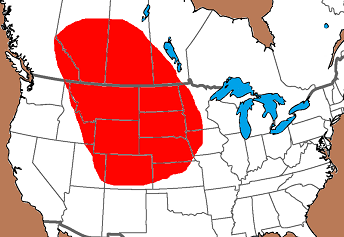

Distribution Comments:
This point is a plains point that is primarily found on the Northern Plains. It is found most commonly in Saskatchewan and Alberta Canada and into Montana, North and South Dakota, and Wyoming. Frequency decreases into Idaho, Utah, Colorado, and Nebraska. It is rarely found on the Colorado Plateau, and is not found in the Great Basin. Morrow (2016) reports this type as rarely found in Minnesota and Iowa.
This point is a plains point that is primarily found on the Northern Plains. It is found most commonly in Saskatchewan and Alberta Canada and into Montana, North and South Dakota, and Wyoming. Frequency decreases into Idaho, Utah, Colorado, and Nebraska. It is rarely found on the Colorado Plateau, and is not found in the Great Basin. Morrow (2016) reports this type as rarely found in Minnesota and Iowa.
Age / Periods:
Date: 3,500 - 2,800 B.P.
Cultural Period: Middle Archaic to Late Archaic
Glacial Period: Neoglacial
Environmental: Sub-Boreal
Culture:
Date: 3,500 - 2,800 B.P.
Cultural Period: Middle Archaic to Late Archaic
Glacial Period: Neoglacial
Environmental: Sub-Boreal
Culture:
Age Details:
"Hanna points are associated with the McKean complex, which has been dated within the 3000 to 500 B.C.E. period. Hanna may have been the predominant point type in the complex between ca. 1500 to 1000 B.C.E" (Morrow, 2016)
"Hanna points are associated with the McKean complex, which has been dated within the 3000 to 500 B.C.E. period. Hanna may have been the predominant point type in the complex between ca. 1500 to 1000 B.C.E" (Morrow, 2016)
Other points in this cluster / Related / Associated Points:
Duncan, Hanna Northern, Mallory, McKean, Yonkee
Duncan, Hanna Northern, Mallory, McKean, Yonkee

